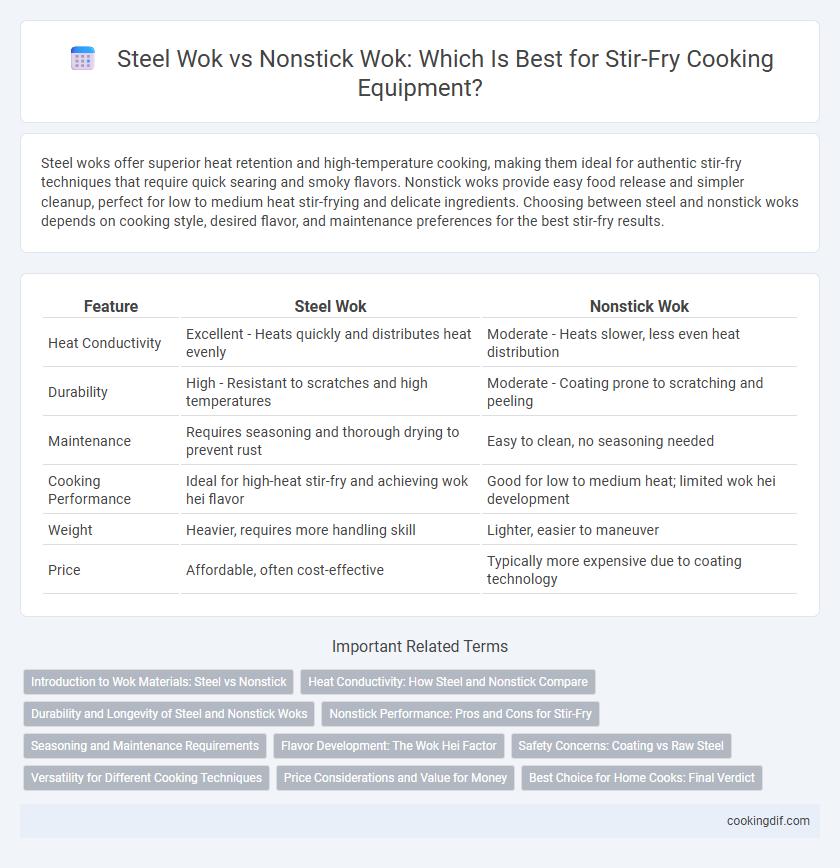Steel woks offer superior heat retention and high-temperature cooking, making them ideal for authentic stir-fry techniques that require quick searing and smoky flavors. Nonstick woks provide easy food release and simpler cleanup, perfect for low to medium heat stir-frying and delicate ingredients. Choosing between steel and nonstick woks depends on cooking style, desired flavor, and maintenance preferences for the best stir-fry results.
Table of Comparison
| Feature | Steel Wok | Nonstick Wok |
|---|---|---|
| Heat Conductivity | Excellent - Heats quickly and distributes heat evenly | Moderate - Heats slower, less even heat distribution |
| Durability | High - Resistant to scratches and high temperatures | Moderate - Coating prone to scratching and peeling |
| Maintenance | Requires seasoning and thorough drying to prevent rust | Easy to clean, no seasoning needed |
| Cooking Performance | Ideal for high-heat stir-fry and achieving wok hei flavor | Good for low to medium heat; limited wok hei development |
| Weight | Heavier, requires more handling skill | Lighter, easier to maneuver |
| Price | Affordable, often cost-effective | Typically more expensive due to coating technology |
Introduction to Wok Materials: Steel vs Nonstick
Steel woks offer superior heat retention and high-temperature tolerance, making them ideal for authentic stir-fry cooking techniques that require quick, intense heat. Nonstick woks provide easy food release and simple cleaning but often lack the durability and high-heat performance of steel, potentially limiting the development of wok hei flavor. Choosing between steel and nonstick woks depends on balancing the need for heat control and seasoning with convenience and maintenance preferences.
Heat Conductivity: How Steel and Nonstick Compare
Steel woks excel in heat conductivity, offering rapid and even heating essential for authentic stir-fry techniques, while nonstick woks generally have lower thermal conductivity, which can result in uneven cooking. Carbon steel woks, in particular, respond quickly to temperature changes, enhancing control during high-heat searing and tossing of ingredients. Nonstick coatings provide convenience by reducing food sticking but may not withstand the intense heat required for traditional stir-frying without degrading.
Durability and Longevity of Steel and Nonstick Woks
Steel woks are renowned for their exceptional durability and ability to withstand high heat without warping, making them ideal for long-term use in intense stir-frying. Nonstick woks offer ease of cleaning and food release but tend to have a shorter lifespan due to coating degradation from frequent high-heat exposure and metal utensils. Choosing a steel wok ensures greater longevity and improved performance for high-temperature cooking techniques central to authentic stir-fry preparation.
Nonstick Performance: Pros and Cons for Stir-Fry
Nonstick woks offer excellent food release and easy cleanup, ideal for delicate stir-fry ingredients like eggs and vegetables, reducing the need for excessive oil. However, their coating can degrade under high heat typical of stir-frying, limiting the ability to achieve optimal searing and wok hei. Choosing a nonstick wok trades off durability and high-temperature performance for convenience and reduced sticking during cooking.
Seasoning and Maintenance Requirements
Steel woks require regular seasoning to develop a natural nonstick patina, enhancing flavor and durability while protecting against rust. Nonstick woks offer ease of maintenance with minimal seasoning needed but typically lack the high-heat performance crucial for traditional stir-frying techniques. Proper upkeep of steel woks involves drying thoroughly and occasional re-oiling, whereas nonstick surfaces demand gentle cleaning to preserve their coating and prevent damage.
Flavor Development: The Wok Hei Factor
Steel woks excel in flavor development by creating the prized wok hei, a smoky, charred essence that enhances stir-fry dishes through high-heat cooking and natural seasoning over time. Nonstick woks lack the ability to reach the extreme temperatures required for wok hei, resulting in less complex flavors and diminished browning. For authentic stir-fry flavor, steel woks remain the preferred choice due to their superior heat retention and seasoning properties.
Safety Concerns: Coating vs Raw Steel
Steel woks offer superior heat tolerance and durability, eliminating risks associated with chemical coatings found on nonstick woks, which can degrade over time and release harmful fumes when overheated. Raw steel woks develop a natural seasoning that enhances nonstick properties safely without synthetic chemicals. Choosing steel woks reduces long-term health risks and ensures cooking safety by avoiding toxic coating breakdown during high-temperature stir-frying.
Versatility for Different Cooking Techniques
Steel woks excel in versatility, delivering high heat tolerance essential for searing, stir-frying, and deep-frying, enabling authentic Asian cooking techniques. Nonstick woks offer ease for low to medium-heat tasks like sauteing and steaming but may warp or degrade under intense heat. Choosing a steel wok ensures durability and adaptability for diverse cooking styles, while nonstick woks prioritize convenience and lighter cooking methods.
Price Considerations and Value for Money
Steel woks typically offer better heat retention and durability at a lower price compared to nonstick woks, making them a cost-effective choice for frequent stir-fry cooking. Nonstick woks, while often pricier, provide ease of cleaning and require less oil, adding value for those prioritizing convenience and health. Evaluating the long-term performance and maintenance costs is crucial to determine which wok delivers the best value for money based on cooking habits.
Best Choice for Home Cooks: Final Verdict
Steel woks offer superior heat retention and high-temperature cooking essential for authentic stir-fry techniques, making them ideal for home cooks seeking durability and versatility. Nonstick woks provide convenience with easy cleanup and require less oil, suitable for quick, low-fat meals but may lack the intense searing power of steel. Choosing between steel and nonstick woks depends on your cooking style and maintenance preference, but for traditional stir-fry flavor and performance, a carbon steel wok remains the best choice for home kitchens.
Steel wok vs nonstick wok for equipment choice Infographic

 cookingdif.com
cookingdif.com